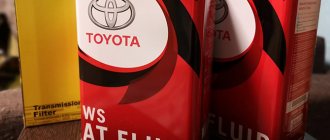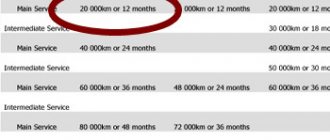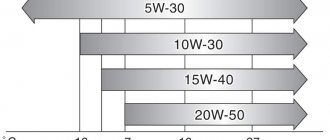The tenth generation of compact Japanese Toyota Corolla cars, which received the factory index E150, boasts both a classic manual gearbox and a hydromechanical and robotic automatic transmission, which were installed on pre-restyling and restyled models of this series from 2006 to 2013. At the same time, according to the recommendation of the automaker, the transmission fluid in these machines must be selected according to factory specifications. Therefore, next we will talk about the oil in the Toyota Corolla 150 automatic transmission, consider its tolerances, and also talk about original and analog transmission oils that can be poured into automatic transmissions of these modifications.
Automatic transmission oil for Toyota Corolla E150
About approvals
The Toyota Corolla E150 model range received at its disposal:
- 4-speed hydromechanical automatic U240E, U340E, U341E series
- 5-speed robot C50A
When choosing oil for these automatic transmissions, depending on the automatic transmission modification, Toyota recommends following the Type WS or MTG Oil LV API GL-4 SAE 75W specifications, which will help you choose the highest quality transmission fluid for these automatic transmissions.
Time for changing lubricant in manual transmission and required volume
According to the manufacturer's recommendations, replacing the lubricant in a manual gearbox on a Toyota Corolla E150 should be done at least every 40 thousand kilometers. In practice, subject to moderate driving, fluid renewal can be done half as often; this procedure is carried out on average once every three years.
Factors indicating the need for another lubricant change in a manual gearbox:
- difficulty changing gears;
- the appearance of extraneous sounds and noises at the moment of gear shifting;
- the appearance of traces of engine oil leakage.
If any symptom occurs, it is necessary to prepare for the fluid renewal procedure, even if the next service is not due yet. In practice, it has been established that a Toyota six-speed manual transmission will require 2 liters of lubricant.
Automatic transmission oil for Toyota Corolla 150 U240E/U340E/U341E (4 gears)
The most popular automatic transmission that the Japanese automaker equipped the tenth generation Toyota Corolla E150 is the Aisin Warner 4-speed hydromechanical automatic transmission of modifications U240E, U340E and U341E. Both pre-restyling and restyled models of this series received this automatic transmission. As for the transmission fluid, Toyota calls for automatic transmissions of these modifications to be filled exclusively with oil with Type WS approval, allowing the use of both original Toyota Type WS oil and its substitutes Aisin ATF AFW+, Kroon Oil SP Matic 4036, and so on.
| Toyota Type WS | 4 liters Article: 08886-02305 Average price: 4000 rubles 1 liter Article: 08886-81210 Average price: 1300 rubles |
| Aisin ATF AFW+ | 4 liters Article: ATF-6004 Average price: 3000 rubles |
| Kroon Oil SP Matic 4036 | 1 liter Article: 32224 Average price: 950 rubles |
Checking the oil level and condition
A running engine, a level platform and the P gearbox set are prerequisites for properly checking the lubricant level. It is advisable that the car not be driven for 4-5 hours before the inspection. However, the automatic transmission and engine must be warmed up to an operating temperature of 80-90 degrees. You can drive 15-20 kilometers or let the engine idle for a while (the air conditioning is turned off). The gearbox lever must be smoothly switched through all steps, then returned to parking mode.
You cannot diagnose the oil level on a car that has previously been driven at high speed for a long time, operated in the heat, or towed a trailer. In this case, you need to stop the car for a day, and only after that proceed to the check.
Instructions for checking the ATF level and condition:
It should be in the Hot zone - quite often it is distinguished by notches on both sides. If the level is lower, add the required amount of fluid. Then check again. It is also important to check the color of ATF and its consistency. The oil should not smell like burning, otherwise this will indicate the need for replacement.
The Cool zone shows the fluid level on a cold engine. It is intended to approximately determine the amount of lubricant in case of replacement.
For most modifications of Toyota Corolla with front-wheel drive, the dipstick is located on the left side of the car in the direction of travel. It displays the amount of fluid in the automatic transmission - not to be confused with the dipstick on the right! But in rear-wheel drive Corollas, which have a longitudinal engine, the dipstick is located in the opening between the rear side of the internal combustion engine and the body - here it is almost invisible.
After 2000, Aisin Warner began producing boxes without a probe. The technology for controlling the lubricant level in this case is different. The manufacturer has provided a special hole at the bottom of the crankcase, through which it is possible to much more accurately determine underfilling or overfilling of automatic transmission fluid.
Transmission oil for automatic transmission Toyota Corolla E150 C50A (robot)
Less commonly, on the Toyota Corolla E150 you can see the 5-speed C50A robot, which was installed on pre-restyling models of this line from 2006 to 2010. This machine, working exclusively with a 1.6 liter gasoline engine, prefers transmission fluid with MTG Oil LV API GL-4 SAE 75W approval. At the same time, Toyota offers for purchase an original oil of its own production called Toyota Gear Oil LV 75W MT. Its analogues that have this specification are MITASU ULTRA LV GEAR OIL GL-4 75W Synthetic Tech and CASTROL SYNTRANS B 75W.
| Toyota Gear Oil LV 75W MT | 1 liter Article: 08885-81001 Average price: 1300 rubles |
| MITASU ULTRA LV GEAR OIL GL-4 75W Synthetic Tech | 4 liters Article: MJ-420 Average price: 4000 rubles 1 liter Article: MJ-4201 Average price: 1300 rubles |
| CASTROL SYNTRANS B 75W | 1 liter Article: 15054A Average price: 900 rubles |
Preparation, tools and replacement
The preliminary stage is studying the safety precautions for servicing a car, as well as preparing tools. Changing the oil in a Toyota Corolla E150 manual transmission is carried out in special clothing and protective gloves, as well as in a sufficient level of lighting. Before performing the procedure, you must allow the car to cool for 20 minutes.
Tools:
- screwdriver, wrenches, and hex keys;
- an ordinary watering can and a half-meter hose;
- special gaskets for filler and drain holes;
- free container for draining used consumables.
Step-by-step instruction
After purchasing a new consumable, you need to prepare the tools and garage space for the oil change procedure in a 2008 Toyota Corolla box.
- First of all, we drive the car into the “pit”, remove the protection and dismantle two plugs: drain and filler, and then drain the old lubricant into an empty container.
Location of drain and filler necks
In order to remove the protection, you will need a 17-size wrench, and to remove the plugs, you will need a 24-size wrench. On the dismantled plugs, the car owner may see a warning about the need to first study safety precautions. The spent consumables are completely drained within 20 minutes.
- After draining, we evaluate the condition of the lubricant.
If chips appear, rinse and clean the tray. As a rule, the color of the drained lubricating fluid is practically no different from the new one, otherwise there is a malfunction in the operation of the gearbox. The drain plug on the model in question is not equipped on the inside with a special magnet that effectively collects chips, as in cars of other brands.
You need to buy new O-rings
- Then you need to tighten the plug on the drain hole.
Next, using a watering can and hose, you need to pour new fluid into the filler hole.
- Be sure to check the oil level in the box; lubricant should be at the bottom edge of the filler hole.
Upon completion of the oil renewal procedure in the Toyota Corolla E150 manual transmission, you should tighten the filler cap and also return the protection to its place.
This is interesting: Nissan Tiida cabin filter: where is it located, replacement
What kind of oil is in the automatic transmission of a 2012 Toyota Corolla 150
The 2012 Toyota Corolla E150 models belong to the restyled series, which was produced by the Japanese automaker from 2010 to 2013. As an automatic transmission, these cars were equipped with the above-described 4-speed Aisin Warner automatic transmissions of modifications U240E, U340E and U341E. Accordingly, the oil in these automatic transmissions is selected according to the Type WS specification. This can be either the original Toyota Type WS transmission fluid or its analogues Idemitsu ATF Type TLS-LV, Total Fluidmatic LV MV and others.
| Toyota Type WS | 4 liters Article: 08886-02305 Average price: 4000 rubles 1 liter Article: 08886-81210 Average price: 1300 rubles |
| Idemitsu ATF Type TLS-LV | 5 liters Article: 30040096953 Average price: 2900 rubles 1 liter Article: 30040096-750 Average price: 700 rubles |
| Total Fluidmatic LV MV | 1 liter Article: 199475 Average price: 900 rubles |
Features of choice
All presented products are divided into three large groups: mineral, semi-synthetic and synthetic oils. The first ones are made from oil. They have the lowest cost, and are used in old cars from the 90s to the 70s. If you have a modern foreign car manufactured in 2000 (and later), then it is recommended to use synthetic or semi-synthetic products.
Such oils (unlike mineral oils) have many advantages, including:
- High thermal and chemical stability.
- Higher turnover.
- Resistance to temperature fluctuations.
- Long service life.
- Better penetration.
Synthetics promote the formation of a denser film on the surface of parts, which significantly reduces wear.
If funds allow, order original products from the manufacturer. It is necessary to use TOYOTA Getriebeoil LV 75W, since it was created specifically for this car model and, accordingly, will provide high-quality protection for gearbox components. If these products are too expensive, you can take a closer look at more affordable analogues. Car owners celebrate products from Castrol.
Checking the oil level in a Toyota Corolla E150 automatic transmission
The oil level in the Corolla 150 automatic is checked with a dipstick. This manipulation, which should be performed weekly, consists of the following actions:
- warming up the oil in the machine to 70 degrees
- placing the car on a horizontal surface
- moving the automatic selector to position N
- cleaning the dipstick from oil
- directly measuring the level of transmission fluid in the automatic transmission
Checking the oil level in the automatic transmission using a dipstick
Necessary components for work
To replace the transmission, it is not oil that is used, but a special composition intended specifically for this unit. The container label for this liquid bears the designation ATF (automatic transmission fuid). This liquid is able to function under more difficult conditions, withstanding significant loads. When the gearbox is operating, the operating temperature of the parts reaches 300-400*C.
The torque converter experiences heavy loads: when the car is moving, the temperature of the systems reaches 150*C.
During long-term operation of the gearbox, volatile components evaporate from the solution used for lubrication and cooling, and the composition of the transmission fluid changes, which is unacceptable.
The fluid poured into the Toyota Corolla automatic transmission performs a dual function:
- heat removal from the box parts to the external environment;
- lubrication of contacting parts.
To stabilize the solution at high temperatures and stabilize ongoing processes while preventing oxidation, special additives are added that prevent wear of parts and allow mechanisms to function normally at temperatures from -40* to +150*C.
During long-term operation of the gearbox, volatile components evaporate from the fluid used for lubrication and cooling, and the composition of the transmission fluid changes, which is unacceptable for the normal operation of the mechanisms.
READ MORE: Adaptation of the Toyota Corolla robot box
The type of fluid used for each vehicle's transmission is indicated in the factory documents. The most commonly used type of transmission fluid is DEXRON (modifications I, II, III).
When completely replacing the fluid, it is imperative to determine the labeling of all the necessary components that may be needed for replacement: oil filter, O-rings and gaskets.
Typically, synthetic solutions used for transmission are 2-3 times more expensive than mineral solutions.
It must be taken into account that fluids are poured through the level measurement hole in the gearbox, and in some brands of cars using a control plug in the automatic transmission box.
Automatic transmission oil level
I've been driving for many years, and everything seems to be fine, but the accumulated tension from this fact haunts me at night.
The HOT and COOL levels are marked on the dipstick. So, the dextron level works exactly the opposite - a hot car - the level is on COOL, a cold one - on HOT. And it’s always like this, I’m already used to topping it up when replacing, and everything seems to be in order.
What could this mean?
Well, everything is correct, the only bad thing is that your hot box has a Gold level, you need to top it up. And when it’s cold, are you looking at it with it turned off?
How do you see the level? Stupidly pulled out the dipstick, wiped it, inserted it, pulled it out and looked?? if so, it’s not correct, do a search here, we’ve been told a thousand times (including me) how to check the oil level correctly
I don't need a signature. I don’t advertise anything, I don’t show off anything. I don't use clever quotes.
I look at the level from the AutoDat book. Cold - I move the selector back and forth, and at idle I look at the level - the HOT mark. Hot - COOL.
In general, I topped it up to HOT when it was hot, well, the behavior remained the same, only above the marks. Yes, and if there was not enough dextron, the box would slip on the slides, but there is no such thing.
I went to a local auto repair shop and they said the dipstick might be from another car. Something is doubtful.
Actually, the level in the automatic transmission is checked when it is “hot”, at operating temperature
.. With the engine running, move the selector knob through all positions several times, delaying each for a few seconds, then check the level in the “P” position..
VAZ 21093 90 g Toyota Corolla 86 g Toyota Vista SV-40 4S-FE “Etoile” BTPMK A140L-06A 95 g HBO
I'll join! And one more thing... It takes at least 20 km for the box to become hot. drive around the city, because the gearbox only heats up when switching... At XX, at least thresh the engine until the dexron warms up from the antifreeze, look at the COOL. I only measure the level then. when you can no longer hold the automatic transmission dipstick in your hands, i.e. meanwhile its at least 70 degrees...
Camry Gracia WAGON 1997 sold, I go on foot, a miser pays twice, a fool pays three times, and a loser always...
Actually, the level in the automatic transmission is checked when it is “hot”, at operating temperature
By your logic, the COOL label is not needed, it turns out, since it is checked for “hot”. So?
At XX, at least thresh the engine until the dexron warms up from the antifreeze, look at COOL. I only measure the level then. when you can no longer hold the automatic transmission dipstick in your hands, i.e. meanwhile its at least 70 degrees...
And here it’s not at all clear what you wanted to say. Watch COOL on singles? I did that too.
If the vehicle is not moving, place it on a flat surface, apply the parking brake, and start the engine. With the engine idling, depress the brake pedal and move the selector lever through all positions, starting and ending in the “P” position. With the engine idling, remove the dipstick from the tube. Check the fluid level on the dipstick and its condition. If the fluid in the automatic transmission is cold, then the level should be between the two lower notches; if it is at operating temperature, then the level should be between the two upper notches.
Address: Kazan Messages 11,385
It’s more likely not AVTODAT, but some kind of samizdat))) “notches”)))) I haven’t seen anything similar in any serious instructions..
My conscience is clear - I don’t use it......
VAZ 21093 90 g Toyota Corolla 86 g Toyota Vista SV-40 4S-FE “Etoile” BTPMK A140L-06A 95 g HBO
Address: Armavir Messages 1
What should I do? You're measuring the level correctly. What kind of liquid is there? Maybe it’s not Dexron at all...
Camry Gracia WAGON 1997 sold, I go on foot, a miser pays twice, a fool pays three times, and a loser always...
On Toyotas, the level in the automatic transmission is checked on a warm box. When the engine is running, it is in “P” position. The level should be no higher than the “NOT” mark on the dipstick, and no lower. Don't measure when it's cold, it will be more accurate when it's hot.
VAZ 21093 90 g Toyota Corolla 86 g Toyota Vista SV-40 4S-FE “Etoile” BTPMK A140L-06A 95 g HBO
Address: Kazan Messages 11,385
Most likely you are not measuring correctly, if the level did not match.... The automatic transmission would have stopped working long ago...
My conscience is clear - I don’t use it......
Guys, don’t worry when the oil is cold on the dipstick from the top mark, the level should be more than a centimeter by two to two and a half hits 100%, I changed the liquid myself several times, then when it was heated, everything was fine
VAZ 21093 90 g Toyota Corolla 86 g Toyota Vista SV-40 4S-FE “Etoile” BTPMK A140L-06A 95 g HBO
Automatic transmission problems on Toyota Corolla
A small amount of lubricant in the box can lead to a huge number of problems. As a rule, when its level is low, the pump pumping oil begins to capture air along with the working fluid. As a result of this process, an emulsion is formed that compresses very well. The oil begins to lose one of its most important properties - it becomes easily compressible under good pressure. And this already leads to the emergence of such problems as:
Therefore, you should carefully monitor the amount of oil in the automatic transmission of your car, otherwise you will have to pay a lot of money for its restoration and repair because of some little thing.
An excess can lead to increased load on the oil pump, as a result of which it can easily fail. And since they are not repairable, replacing it can cost a lot. Having dealt with possible problems, let's talk about how much oil needs to be poured into the box and what volume is optimal for the normal operation of the box.
When to change the oil in an automatic transmission?
The timing of replacement directly depends on the specific operating conditions and driving style. According to the regulations, an average interval of 50-80 thousand kilometers is recommended, taking into account the active operation of the car all year round in urban conditions. As for the inspection time, it is recommended to do this regularly, every 30-40 thousand km. If driving conditions are even more severe, the vehicle is often loaded above normal, or is driven in difficult conditions in winter, lubrication renewal and quality control must be carried out more often.
Interesting! The official Toyota dealer directly states that the ATF is not replaceable for the entire guaranteed period - 100 thousand km or 3 years of operation. But the gearbox manufacturer Aisin, on the contrary, recommends changing the technical fluid at least once every 2 years or every 20 thousand km. From their point of view, only a complete change using a professional installation seems to be a priority.
You can determine oil wear by the color of the fluid. At first, Toyota ATF is red, then it becomes transparent. If the lubricant becomes cloudy or has a burning smell, it must be replaced without delay, without waiting for the scheduled date. Also, the liquid should not have a dark brown tint. To more accurately determine its quality, you need to drip a little from the probe onto a white napkin. If the lubricant is completely absorbed without leaving mechanical inclusions on the paper, it is clean and does not need to be replaced. The presence of large chips, metal shavings and other foreign inclusions in it will indicate the need for urgent transmission diagnostics and repairs.
The specific condition of the automatic transmission can be found out at a car service center, where specialists carry out all the necessary tests. Qualification allows them to determine whether it is worth repairing the machine or whether it is more rational to buy a new one. Often, in the early stages of malfunctions, it is enough to replace the clutches of a burnt clutch pack or restore the operation of the donut.
How to check correctly?
As a rule, checking the amount of oil on Japanese automatic gearboxes is carried out with the engine running and the “P” mode set. Almost all drivers who drive an automatic transmission know that the “P” mode means parking. The photo shows the shift lever for a Toyota Corolla automatic transmission.
Next, after starting the engine and putting it in parking mode, we find the location of the dipstick in our car. This is very easy to do - you just need to look through some technical documentation and find its location in your car. Or you can pay attention to the picture below and see where this probe is approximately located.
Having found it, we take it out and wipe it with a dry cloth, preferably one that does not have lint. After we wiped it off we can see some marks on it. As a rule, there are only two of them: the first is COOL. This mark is used to check the oil on unstarted vehicles. It is advisable that the car not be driven for at least 4-5 hours before the inspection. The second mark is HOT. This mark is intended to check the oil level when the machine engine is running. In the photo below you can see how and where the marks are located.
Having seen the marks, it is worth saying that although there are two marks there, it is best to check the level with the engine running and preferably warmed up to the average normal temperature. Typically it is 90 degrees Celsius.
So, we warmed up the car, pulled out and wiped the dipstick, put it back in its place, wait a few seconds and pull it out again. It should clearly show the lubricant level in the automatic gearbox of your Corolla.
If its level is below the HOT mark, then it is worth adding it little by little with the engine off. Then, check again by performing the above procedure again. After the lubricant has been added and its level is back to normal, we install the dipstick in its place and we can drive without problems. This completes the automatic transmission check procedure. Now it’s worth talking about the problems that can arise from a lack of lubricant in the box or, conversely, from its excess.
How much lubricant to pour into an automatic transmission on a Toyota Corolla?
You, Corolla owners, change approximately from 4 to 5.5 liters. The volume depends on the type of automatic transmission, on the model of the car itself, since models of different years usually have different automatic transmissions, with a different number of gears, etc.
KEY-DOP
In order to know exactly the required amount of lubricant , you need to read the technical documentation and find out the requirements set by the manufacturer for a given vehicle. If the material is filled, start the car, warm it up and be sure to check its quantity on the dipstick. If the level is lower, then you need to add oil; if the level is higher, then you need to drain the oil a little. Therefore, we need to achieve the ideal level for your box. Thanks to this process, your car will enjoy its durability and quality of service.











